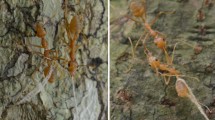Summary
Ants are known to distinguish their own nests and nestmates from all others, using colony-specific odors. Here I show that harvester ants (Pogonomyrmex barbatus) can further distinguish between two kinds of non-nestmates of the same species: neighbors and strangers. Interactions between colonies were thought to depend on the numbers of alien ants that each colony encounters on its territory. The results described here show that such interactions also depend on information about colony identity. Encounters on foraging trails with ants from neighboring colonies, deter foraging more than encounters with ants from distant ones. The history of interactions between particular pairs of colonies may have important effects on intraspecific competition for food.
Similar content being viewed by others
References
Brown JH, Davidson DW (1977) Competition between seed-eating rodents and ants in desert ecosystems. Science 196:880–882
Carlin N, Holldobler B (1986) The kin recognition system of carpenter ants (Camponotus). I. Hierarchical cues in small colonies. Behav Ecol Sociobiol 19:123–134
Davidson DW (1977) Species diversity and community organization in desert seed-eating ants. Ecology 58:725–737
DeVita J (1979) Mechanisms of interference and foraging among colonies of the harvester and Pogonomyrmex californicus, in the Mojave desert. Ecology 60:729–734
Falls JB (1982) Individual recognition by sound in birds. In: Kroodsma DE, Miller EH (eds) Acoustic Communication in Birds, vol 2: Song Learning and its Consequences. Academic Press, London
Falls JB, Brooks RJ (1975) Individual recognition by song in White-Throated Sparrows. II. Effects of location. Can J Zool 53:1412–1420
Gordon DM (1987) Group level dynamics in harvester ants: young colonies and the role of patrolling. Anim Behav 35:833–843
Gordon DM (1988) Nest-plugging: interference competition in desert harvester ants (Pogonomyrmex barbatus and Novomessor cockerelli). Oecologia 75:114–117
Gordon DM (1989) Dynamics of task switching in harvester ants. Anim Behav 38:194–204
Gordon, DM, Holldobler B (1988) Worker longevity in harvester ants. Psyche 34:361–446
Harkness RD, Isham V (1988) Relations between nests of Messor wasmanni in Greece. Ins Soc 35:1–18
Harrison JS, Gentry JB (1981) Foraging pattern, colony distribution and foraging range of the Florida harvester and, Pogonomyrmex badius. Ecology 62:1467–1473
Hepper PG (1986) Kin recognition: Functions and mechanisms. Biol Rev 61:63–93
Holldobler B (1976) Recruitment behavior, home range orientation and territoriality in harvester ants, Pogonomyrmex. Behav Ecol Sociobiol 1:3–44
Holldobler B, Carlin N (1987) Anonymity and specificity in the chemical communication signals of social insects. J Comp Physiol 161:567–581
Holldobler B, Lumsden C (1980) Territorial strategies in ants. Science 210:732–739
Holldobler B, Michener CD (1982) Mechanisms of identification and discrimination in social hymenoptera. In: Markl H (ed) Evolution of Social Behavior: Hypotheses and Empirical Tests. Verlag Chemic Weinheim, Dahlem Konferenzen, pp 35–58
Obin M (1986) Nestmate recognition cues in laboratory and field colonies of Solenopsis invicta Buren. Effect of the environment and role of the hydrocarbons. J Chem Ecol 12:1965–1975
Sherman PW, Holmes WG (1982) Kin recognition: suggestions and evidence. In: Holldobler B, Lindauer G (eds) Experimental Behavioral Ecology. Fischer Verlag, Stuttgart
Whitford WG, Johnson P, Ramirez J (1976) Comparative ecology of the harvester ants Pogonomyrmex barbatus (F. Smith) and Pogonomyrmex rugosus. Ins Soc 23:117–132
Wilson EO (1975) Sociobiology. Belknap Press of Harvard University Press, Cambridge
Author information
Authors and Affiliations
Rights and permissions
About this article
Cite this article
Gordon, D.M. Ants distinguish neighbors from strangers. Oecologia 81, 198–200 (1989). https://doi.org/10.1007/BF00379806
Received:
Accepted:
Issue Date:
DOI: https://doi.org/10.1007/BF00379806




